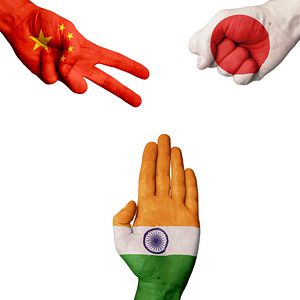Both Nitin Gokhale and Sanjay Kumar have cautioned in these pages that as India deepens its strategic partnership with Japan, it must be careful to consider its bilateral position vis-a-vis China. Given geopolitical realities in Asia today, Beijing is noticeably and understandably concerned with the growing rapprochement between Asia’s largest and richest democracies. While neither India nor Japan can independently stand against China on most standard measures of state power, together they form a considerably robust bulwark for the status quo in the region. For New Delhi, the ideal scenario would be to maintain positive economic relations with both countries while deepening security and strategic cooperation with Tokyo and maintaining an amicable detente with Beijing. In short, New Delhi seeks a positive-sum outcome with both countries. Achieving this won’t necessarily require traditional balancing, where New Delhi modifies its behavior to comply with the preferences of other actors (in this case Beijing). Rather, India’s interests would be best served by decoupling material and economic questions from broader strategic and security issues.
“Decoupling” is something that nearly every diplomatically mature state does — or at least tries to do. Simply put, the term describes the management of economic relations, including investment, development, and trade agreements, independent of broader strategic issues. The contemporary relationship between the United States and China is a good example of a relatively successfully decoupled bilateral relationship — major strategic issues persist but economic interdependency is amply developed, resulting in stability and mutual growth. India would do well to take this diplomatic paradigm to heart when it comes to interactions with both Beijing and Tokyo. As Modi’s recent visit to Japan demonstrates, in the India-Japan relationship, strategic issues, such as defense cooperation and even the civil nuclear cooperation agreement, run on a different track than economic issues. Modi returned from Tokyo with $34 billion in Japanese investment in tow while issues like the ShinMaywa US-2 aircraft deal, civil nuclear cooperation, and the two-plus-two dialogue were set aside for later. In broader terms, since the 2006 declaration of a “Strategic and Global Partnership,” economic and strategic relations have grown at different paces.
Furthermore, what makes decoupling a viable option for New Delhi today is the recent Chinese “charm offensive” since Modi’s election. Beijing has been uncharacteristically keen to normalize relations with India, moving away from the troubling April 2013 border stand-off and other issues. New Delhi would do well to seize on this Chinese overture, significantly expanding economic relations between Asia’s two giants. This is easier said than done, however. As we’ve discussed here at The Diplomat before, the asymmetric nature of the strategic rivalry between India and China has manifested in a way that is detrimental for India in terms of its material relations with China. When it comes to its relations with Beijing, New Delhi finds it almost impossibly difficult to conduct productive and stoic diplomacy despite the legacy of the 1962 war, current border disputes, and repeated Chinese slights along the McMahon line. This must change. This isn’t a call for appeasement or for ignoring the important differences that continue to persist between these two countries; instead, New Delhi should conduct economic diplomacy pragmatically and remain vigilant regarding strategic issues. Xi Jinping’s upcoming visit to India will be important to watch in this regard.
Ultimately, it should be New Delhi’s goal to establish a state of affairs with Beijing where economic interdependence is sufficiently high that even if Beijing should express displeasure over continued India-Japan rapprochement, it would balk at materially pressuring or sanctioning New Delhi. Given current circumstances and the apparent dynamism of the new leadership in New Delhi, this should be a guiding principle of Indian diplomacy towards China. What would prove detrimental to India’s national interest is an excessive concern with how its relationship with Tokyo will affect Beijing’s perceptions. This carries the risk of leading to a scenario where New Delhi grows increasingly reticent toward Tokyo, and meanders along, leaving the “Strategic and Global Partnership” woefully under-capitalized. Fortunately, judging by his rhetoric and behavior in Japan, Modi has signaled a rejection of non-alignment and even semi-alignment. He takes for granted that the partnership between India and Japan is just picking up and has plenty of room for growth.
While Modi’s approach toward Japan is encouraging and largely compliant with the rubric I’ve laid out, his approach and thinking toward Beijing is less so. Modi has repeatedly made pointed comments about Chinese expansionism, including during his trip to Japan. Additionally, his government has demonstrated a propensity to go tit-for-tat with Beijing on certain sensitive issues, including border disputes. As I noted above, we’ll learn more about Modi’s intentions for China during Chinese President Xi Jinping’s highly anticipated trip to India this month. Beijing has already begun to decouple its approach to India, emphasizing the room for positive-sum cooperation between the two countries. New Delhi should embrace this opportunity.
As Gokhale correctly notes, Modi’s dynamism on foreign policy since his inauguration in late May demonstrates that he likely possesses the creativity and gumption necessary to navigate India’s complex strategic environs. Modi’s “economy first” pitch enamored him to Indian voters. Discussing economics first and all other issues second will give India the diplomatic latitude it needs to appropriately nurture its partnership with Japan while capitalizing on all that China has to offer.

































